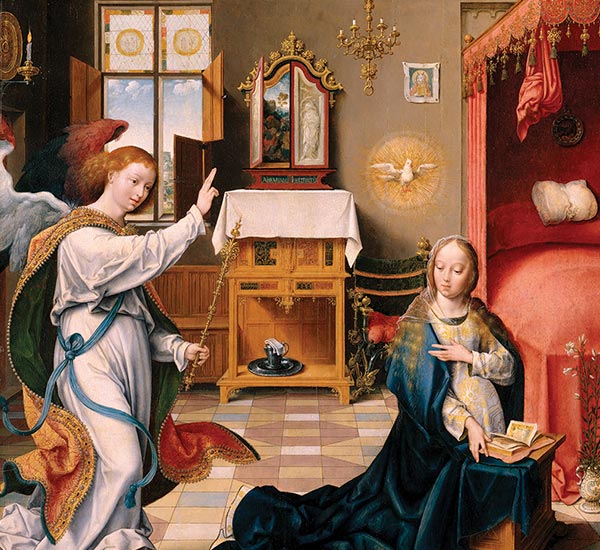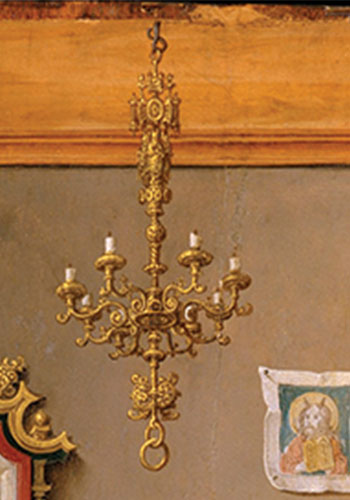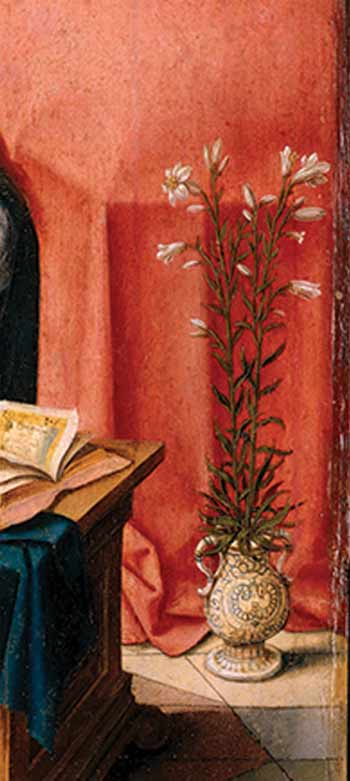Subtotal: $
Checkout-

Insights on Beauty
-

It Could Be Anyone
-

All About Light
-

Making a Work of Art
-

The Business of the Artist
-

The Creative Process
-

Return to Appalachia
-

Excerpt: Mandela and the General
-

Why We Live in Community: A Manifesto
-

Editor’s Picks Issue 18
-

The Sacred Bonds of Sound
-

Making Music for Community
-

A Man of Honor
-

Wassily Kandinsky
-

Giant Picnic
-

Covering the Cover: The Art of Community
-

The Art of Community
-

Readers Respond: Issue 18
-

Family and Friends: Issue 18
-

I Did Not Leave
-

Summer of the Tree House
-

Warriors on Stage

Artists in the Christian tradition have been inspired by the New Testament stories, and one story in particular has prompted them to reflect on the nature of beauty and its place in our lives: the story of the Annunciation. In this story we encounter a moment of interaction between the human and the divine, when an angel appears in the most private and protected part of a woman’s home. The light that radiates from the angel falls not only on Mary but on all the objects that surround her, showing the fitness of the woman for her holy task in the order and beauty of her room. The Annunciation by the Dutch master Joos van Cleve (1485–1540) illustrates the point. None of the objects among which Mary sits is purely functional: everything has an edge, an embellishment, a kind of gentle excess. The furnishings are not just accidentally there: they are there because they are also owned, shaped, and cherished. Mary has arranged the room with beauty in mind, so as to be a fit welcome for an angel.

Joos van Cleve, The Annunciation
Image from WikiArt (public domain)
We find the same cherishing of objects in later Dutch interiors, when the secular vision had begun to replace the religious. In an interior by Vermeer we see people set among objects that shine with the light of ownership. They have been brought into the house, so to speak, polished like mirrors, so as to reflect the lives and loves surrounding them. A kind of tenderness radiates from the objects in such paintings, to embrace the viewers and to tell them that they, too, are at home, among these things rubbed smooth by human affection.
In everyday life we are not animated, as a painter might be, by high aesthetic ideals. We are not trying to reveal the meaning of things, or to create compositions that convey a higher sense of order. Nevertheless we arrange things around us and try to make them fit together in something like the way they fit together in a painting, as when we lay a table for guests or arrange our room. Even in the most minimal tidiness we subject the objects around us to a kind of moral discipline. We tell them: you should stand here, you two should be together, you are the wrong color, you are out of place, you are just the right shape to be there.
For whose sake are we doing this? Not for the sake of the objects themselves, for they have no “sake.” Look at them as they are in themselves and they become inert, inanimate, awaiting our instructions. When we arrange them, however, we do so for the sake of people: not just this person here, who is laying the table, but any other person who might come along, who might even be a visitor from the realm of angels. While we think we are making one object fit to another, and each object fit to the whole, we are actually fitting the objects to an imagined community of people.

The idea of what is “fitting” takes its sense from a wider experience of community. People learn to adapt their behavior, their remarks, and their expressions to the demands and expectations of others around them, and this is what we mean by manners. It is from the resulting conventions, customs, and concessions that we draw our conversational repertoire. Knowing how to address a stranger in a new situation, how to move painlessly and quickly to a spirit of cooperation: these are not easy things to learn. But when we have learned them we have also learned something else: a comprehensive sense of the distinction between “fitting in” and “standing out.” The most common form of rudeness involves standing out at all costs, drawing attention to yourself, regardless of whether you deserve it, dismissing attempts to fit in as the ploys of little people who cannot live in a more interesting way.
Good manners, therefore, mean fitting in. And our general sense of manners extends from people to objects, and from the domestic objects that accompany our daily lives to the wider environment, whether built or farmed or left as wilderness. Understanding this is the first step to grasping the role of beauty in the shaping of human communities. Ever since the rise of aesthetics as a philosophical discipline in the seventeenth and eighteenth centuries, writers and artists have tended to a transcendental view of beauty, as a value that lifts us above the things of this world to a realm of pure ideals. Beauty became the preserve of the artist, who could see through the muddles and compromises of ordinary existence to the sublime visions that only genius can perceive. This romantic idea misrepresents not only the concept of beauty, but also its place in the lives of ordinary human beings.
When we make aesthetic judgments we do not, as a rule, praise things as beautiful, sublime, or transcendental, in the manner of the romantic artist. We say instead that this is right, that wrong; this fits, that jars; and so on. In other words we extend the language of manners to the world of inanimate things, and in doing so we make them animate: we bring them into the community and subject them to the rules of good behavior. Hence “right” and “wrong” have a far greater role than “beautiful” and “ugly” in the aesthetics of everyday life, and that is as it should be, since everyday life aims at accommodation and equilibrium. It does not aim at the great experiences that shake us to the core, and which we can absorb, if at all, only on the special occasions when we are consciously exposed to them.
This does not mean that beauty has no place in ordinary things. On the contrary; it means that it does have a place, but a place that is adapted to everyday experience, so as to guide our judgments of what fits, what harmonizes, what is right here and now. This judgment makes sense because it brings with it an incipient sense of community. It speaks for the indefinitely many others who stand at our shoulders when we ask the question whether this or that arrangement is right, or whether it “works.” Everyday aesthetic judgment is profoundly rooted in the sense of community, and also forms a part of the collective effort whereby communities are brought into being and maintained in equilibrium.
There is no clearer proof of this than the cities bequeathed to us by former civilizations, where we gaze with wonder at the way in which every nook and cranny, every corner and parapet, is embellished with ornament and fitted to its neighbor. We are presented with an overwhelming sense of a community united in its determination to be, in which buildings stand side by side in full acknowledgement of each other’s right, in which space is something shared, and each detail offers itself to the eye as a subject of judgment.
Consider Venice. It is full of grand palaces, and contains the greatest interior of any building anywhere, the golden tent of Saint Mark’s Basilica, encrusted with mosaics and shining with a light that is not of this world. But that is not, I think, what most inspires the visitor. More astonishing than Saint Mark’s, more endearing than the church of Santa Maria dei Miracoli, more touching than the lace-like finish of the Ducal Palace, are the ordinary doorways on the backwater canals, the marble-lipped bridges across them, the shrines and niches that punctuate the walls, the sense all about you of a meticulous but effortless aesthetic order, in which all the residents have willingly collaborated over centuries, so as to make their city, planted against the odds in the swamps of the Adriatic, the greatest shared space that has ever been made. There is not a wall, a doorway, a window frame, a roof, or a crenellation that has not been furnished in a spirit of love, adjusted not so as to express the power or grandeur of the would-be resident, but so as to embellish the space in which it stands. Things built in Venice have been built for others: the indefinitely many others who have been, are, and will be resident on these islands and conveyed through these canals.

This does not mean that the ordinary buildings of Venice are great works of art. Students of Venetian history will know that this tiny city, scarcely bigger than Greenwich Village, has throughout its history sustained every imaginable form of voluntary association, from the dignified scuole of the guilds and tradesmen to the masked balls of the aristocrats and the tournaments and commedie of the street. The city has existed in a continuous state of peaceful revelry and lawful self-government for a thousand years, and this great fact is written in the architectural palimpsest that shines on the water in every small canal. We should be in no doubt that the strength of Venice, its determination to defend itself right down to that final moment when Napoleon subdued the city to his grim project of a Europe united under French protection, was inseparable from its beauty. It is not brute force or wealth but beauty that inspired the citizens both to stand side by side against external aggression and to live harmoniously together by sharing what they had.
At a certain stage, as we know, all such efforts at a collective aesthetic fell into disrepute. Sometime in the run-up to the First World War the celebrated Austrian architect Adolf Loos informed us that “ornament is crime,” and to whoops of delight from the architectural profession his bon mot became an aesthetic orthodoxy. Why did he say it, though? In late nineteenth-century Vienna, tenements and factories were springing up encrusted with irrelevant cherubs and ludicrous mouldings like the icing on decorated cakes. Ornaments once spontaneously adopted as part of the collective spirit of dwelling were now borrowed, stuck on, as though to disguise and sweeten a form that would otherwise protrude into the space of the city like a naked stranger. Ornament, in such circumstances, was not a step towards aesthetic order, but a pretense, a way that architects disguise what they are not prepared to affirm.
When we build settlements today we should begin always with an act of consecration.
Americans have perhaps suffered more than others from the long-term effect of this assault on ornament. The late twentieth century gave rise to a raw, functional way of building, associated not only with architecture but with every aspect of daily life in which objects have a significant part to play. It is no longer things that are in the service of man, but man who is in the service of things. Shorn of all ornament, ostentatiously declaring that they are nothing but their function, objects defy our humanity, tell us to give up on the idea that we can relate to the world in some other way than by using it. We once believed that objects, like people, should be treated as ends in themselves, and not as means only. We wished for them to be, as in the great days of Venice, enchanted by their human uses, full participants in a community united by style. But that attitude to objects has been banished to the realm of illusion. It is a fairy tale, like Father Christmas.
This has had devastating consequences when it comes to the design of towns and cities. American cities do not have nooks and crannies. Corners occur only because the sheer sides of curtain walls crunch together. There are no places “left over” from the great computerized forms that commandeer the ground plan, and nowhere can the little sheds, shrines, and shelters that barnacle our ancient cities gain a hold on the unornamented structures that in America stretch from the street to the sky. As a result of this, the city does not belong to its residents, nor they to the city. When the day is over Americans flee from the downtown to the suburbs, where they can be at home in a place where ornament is allowed and things can look right. But the space of their aesthetic experiments is a constricted space, and its design is directed only to the family, and not to the wider community. The houses stand amid their swards of mown grass in no very clear relation, and although Americans are good neighbors and charitable people, their sense of community stops short of taking collective decisions as to how the neighborhood should be constructed so as to belong to them all.

Even so, wherever people build, decorate, and shape things with a view to belonging, a kind of order can emerge. For we are naturally home-building creatures, and this can be observed in that very American product, the trailer park. I say product, but of course it is more a by-product of poverty than a product in itself. Nevertheless, there is not a trailer-park in America in which the residents do not attempt to match the style, colors, and posture of the surrounding units, so as to make of their trailer a home among homes. We cannot settle without also making a settlement, that is to say, a place that is “ours.” Our deepest social need is for the first-person plural of belonging, and to belong is to belong in a place.
And here, I think, it is important to look back to the beginning of human settlement. Human beings distinguished themselves from the rest of nature in the manner of the trailer-park resident, namely, by settling down. We settled down in a place, so as to farm it for food, and to be at home there. A settlement is not just a habitat, but a place that is claimed as “ours.” And what was the first thing that we did to mark our patch of ground? It was to consecrate the place as sacred, and then to build a shrine.
Every great city in Europe was built around a church, and it is from the church and the temple that the vocabulary of classical ornament has been taken. What went wrong in Adolf Loos’s day was not that ornaments were being abused – although of course they were – but that people had lost the faith from which the original habit of ornament stemmed. The cherubs and acanthus leaves, the mouldings and grape vines, had been stolen from temples from which the gods had fled, and put to profane uses. Architecture had been severed from its sacred origins, and desecrated. Loos’s cry against ornament was like the cry of the seventeenth-century puritan against the Roman Catholic Church – a protest against the profanation of a shrine by the gaudy trappings of religious pretense.
I don’t say that Loos was right. But I believe we should always bear in mind, when trying to understand what Milan Kundera has called “the uglification of our world,” that these questions have much to do with long-standing disputes concerning the place of religion in everyday life. Who can doubt, on visiting Venice, that this abundant flower of aesthetic endeavor was rooted in faith and watered by penitential tears? Surely, if we want to build settlements today we should heed the lesson of Venice. We should begin always with an act of consecration, since we thereby put down the real roots of a community.
Already a subscriber? Sign in
Try 3 months of unlimited access. Start your FREE TRIAL today. Cancel anytime.

































Stevenson Smith
There’s more too it than religion. Consider Utah — the most religious state in America, once a Mormon theocracy, organized and built around a religious temple in the literal center of Salt Lake City. And yet, Utah is an architectural mess fully representative of the American industrial/suburban ethos.
Ehall
Great
Laszlo Ptarmigan
Mr. Scruton makes a good point.